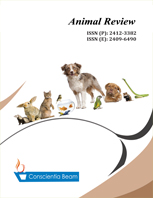Helminths and Protozoa of the Gastrointestinal Tract of Ruminants in Tanzania
DOI:
https://doi.org/10.18488/journal.ar.2017.42.21.34Abstract
Tanzania has one of the largest populations of domestic ruminants in Africa. Their performance is less than their potential. Health, particularly disease due to gastrointestinal parasites, is a major constraint to improved productivity. Internal parasites also affect the country’s very diverse and huge array of wild ruminants. This review is based on a thorough search of the formal and informal literature pertaining to gastrointestinal parasites of ruminants in Tanzania. The occurrence and geographical distribution of helminth (nematodes, trematodes and cestodes) and protozoan parasites are presented. Cattle, goat and sheep nematodirus (roundworm) infection usually comprises mixed infections of several taxa of which 13 species in nine genera have been recorded. A total of seven species of trematodes (flukes) in six genera have been found. Some six species of cestodes (flatworms) have been recorded, three being in the genus Taenia. The most prevalent species of protozoan parasites, of which seven have been identified in cattle and 18 in sheep and goats, belong to the genus Eimeria: four other species of protozoan parasites are also recorded. A general overview of the epidemiology of gastrointestinal parasites is provided and the main methods of control are discussed.

